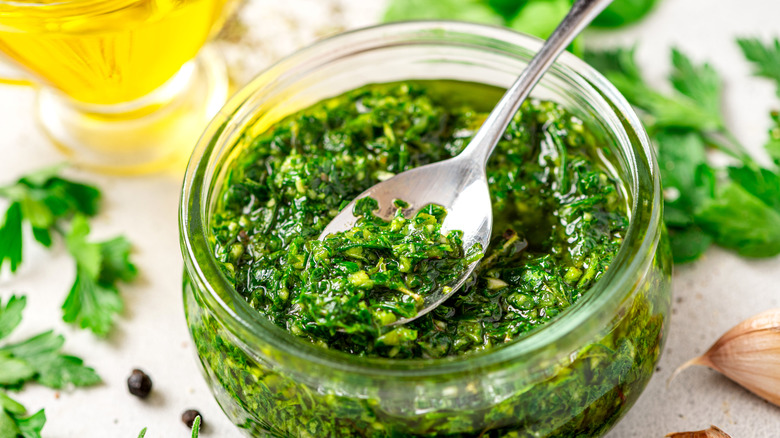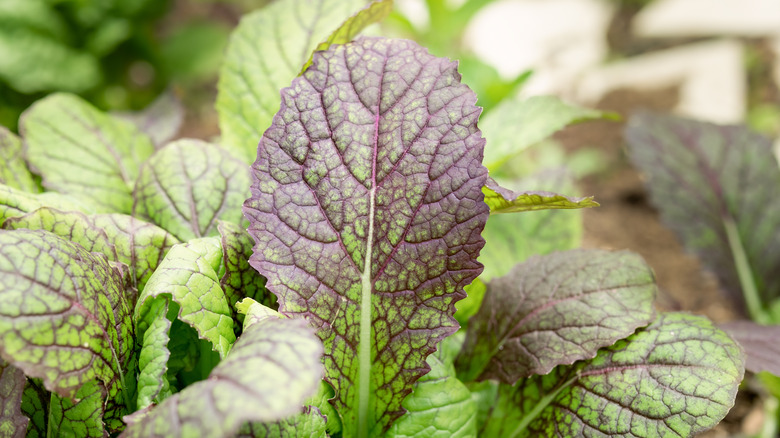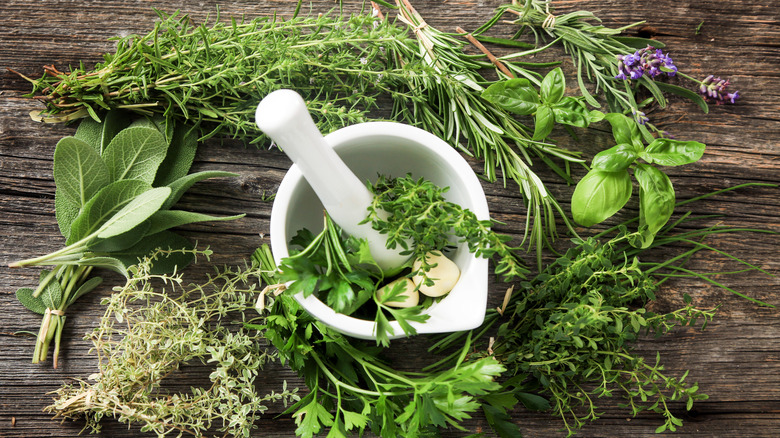Mustard Greens: The Ingredient Your Chimichurri Needs For A Peppery Punch
Bright in both color and flavor, chimichurri sauce is a ubiquitous condiment throughout South America although the origins of chimichurri are somewhat mysterious. Some claim that the sauce was created by gauchos, horsemen who roamed the grasslands of Argentina and Uruguay in the 1800s, while others say it comes from the similarly pronounced Basque word "tximitxurri" and was brought over by Basque migrants. Some historians say that the Quechua, an indigenous people from northern Argentina, are responsible for its creation. Yet another legend credits an Irishman named Jimmy with creating the condiment, claiming that "chimichurri" is derived from "Jimmy's curry."
Although its history may not ever be fully agreed on, there's one chimichurri opinion that you don't have to debate — its vivid, sharp flavor is a perfect partner for almost anything that comes off your grill. The traditional sauce gets a green hue from parsley and oregano, and making a simple chimichurri recipe is remarkably easy to do. If you want to pack your condiment with a peppery punch, though, then it might be time to stray from tradition because mustard greens are the flavorful substitute that you've got to try.
Spicy mustard greens enhance aromatics
Creating your chimichurri couldn't be simpler; it's not a sauce that requires cooking, only combining. The basic recipes take chopped parsley and chopped oregano (fresh or dried), red pepper flakes, and minced garlic and mix them with vinegar and olive oil. Although some will suggest using a food processor for a more pureed consistency, it isn't really necessary, as simply stirring the ingredients can work just as well.
A traditional chimichurri provides a sharp acidity from the vinegar, a little heat from the red pepper flakes, and an aromatic earthiness from the parsley and oregano. When mustard greens, which have a spiciness similar to arugula, are substituted for the parsley and oregano, though, those flavors become more intense and the greens' peppery kick shines through.
Raw mustard greens on their own can be quite bitter and pungent, but the vinegar, olive oil, and garlic make the overall flavor more rounded and cut through some of the mustard greens' bite. If you can find it, young mustard with smaller leaves will have a milder flavor too. Either way, the result will be bold, so the sauce is best paired with richer dishes, like steak, that won't be overwhelmed by the taste.
Gather your greens
Depending on the region you live in, you might have some difficulty finding mustard greens in the store. To achieve a similar flavor, other leafy greens such as turnip greens or garlic mustard greens are good substitutes, but you don't have to stick with a peppery kick. Because a chimichurri recipe is so straightforward, it's easy to deviate from the traditional preparation to build your verdant flavor profile.
Mustard greens add their bit of spice, but if you'd rather lean into the sauce's earthier qualities, you can add kale to chimichurri for a slightly rustic snap. Including wild leeks, also called raw ramps, in chimichurri imparts a hint of spicy, garlicky flavor. Basil or mint will add a little pungent sweetness; while tarragon imparts a light licorice quality and thyme offers a mild, savory flavor. Experimenting with adding various herbs and greens to chimichurri is wide open, so turn to what you have on hand and try out the herbs or greens you like. Wherever you land with your viridescent ingredients, chimichurri could easily become a staple sauce in your kitchen.


